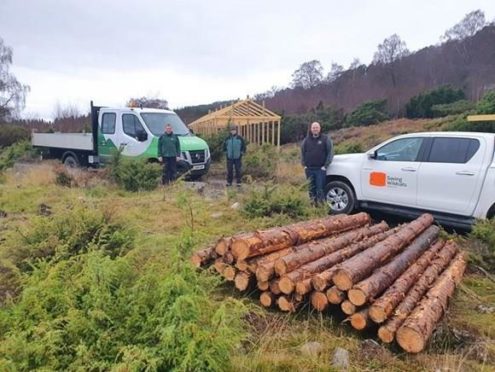Eight new conservation breeding enclosures for wildcats are to be built at Highland Wildlife Park.
Forestry and Land Scotland (FLS) has been helping Saving Wildcats colleagues at the Royal Zoological Society of Scotland’s (RZSS) Highland Wildlife Park to kit out the new enclosures as the next stage of an exciting European partnership project gets underway.
A total of eight enclosures will be built, each one providing an enriching environment for the wildcats with climbing structures, natural vegetation, nest boxes and cover.
Highland Wildlife Park animals helping conservation research
The logs provided by FLS will help wildcat animal keepers create these complex habitats.
Once the enclosures have been constructed, wildcats will then be introduced to each other at the start of the breeding season, between January and March, with the aim of successful breeding in the spring and early summer.
Kittens will stay in these enclosures until they are moved to pre-release enclosures where they will undergo a specific training programme to ensure they have the skills needed to survive in the wild once they are released.
With an unsustainable population of Wildcats now left in the wild in Scotland, FLS and RZSS – both partners in the wildcat restoration project ‘Saving Wildcats’ – are working to create an environment that will help wildcats and their kittens to prosper.
Kenny Kortland, FLS Wildlife Ecologist, said; “We look after our forests in ways that benefit wildcats – creating a mosaic of habitats that meet all of their needs.
“Once the cats are released, we can be reassured that they will find plenty voles to eat and places to shelter in FLS woods.
“In the meantime, we’re very pleased to have been able to help furnish the enclosures.”
Saving Wildcats conservation manager David Barclay said: “The Saving Wildcats Conservation Breeding for Release Centre is a critical component of the long-term restoration plan for our iconic wildcat.
“Our breeding enclosures at Highland Wildlife Park will provide a vital space where wildcats will be born and raised with human contact at a minimum.
“Wildcat numbers are now so low in the wild that, without action dedicated to releasing wildcats, the extinction of the species is almost inevitable.
“Sometimes mother nature needs a helping hand and with the Saving Wildcats project we will be able to give wildcats the best possible start before they are released into the Scottish Highlands.”










